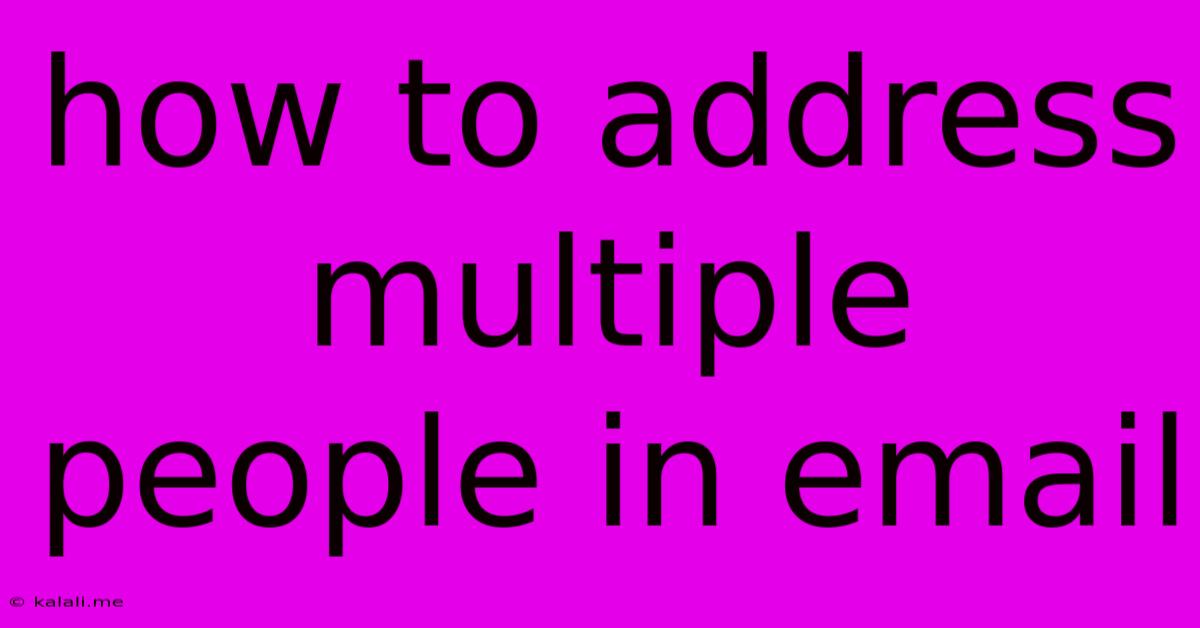How To Address Multiple People In Email
Kalali
Jun 09, 2025 · 3 min read

Table of Contents
How to Address Multiple People in an Email: A Guide to Professional Etiquette and Best Practices
Addressing multiple recipients in an email might seem straightforward, but getting it right impacts professionalism and clarity. This guide provides strategies for addressing various email scenarios, ensuring your message is received effectively and politely. Whether you're emailing colleagues, clients, or a mix, we'll cover the best practices to make your communication shine.
Knowing how to address multiple people in an email is essential for effective communication, showing professionalism, and avoiding misunderstandings. This article will guide you through various scenarios and best practices.
Understanding the Context: Choosing the Right Salutation
The best approach to addressing multiple people depends heavily on your relationship with them and the context of the email.
1. Formal Settings (Clients, Senior Management):
- Using individual names: If you know all recipients, and the email is formal, listing each name individually is generally preferred. For example: "Dear Mr. Smith, Ms. Jones, and Dr. Brown,". This shows respect and personalization.
- Using titles and last names: Always use appropriate titles (Mr., Ms., Dr., etc.) with last names for a formal tone.
- Avoid generic salutations: Steer clear of generic greetings like "Hi Team" or "To Whom It May Concern" in formal settings. These lack personalization and can feel impersonal.
2. Semi-Formal Settings (Colleagues, Regular Contacts):
- Using a group greeting: If you regularly interact with a group, a group greeting like "Hi Team" or "Hello everyone" can be appropriate. Ensure the tone remains professional, even with a more casual greeting.
- Combining names and a group identifier: A blend of individual names and a group identifier can work well. For example, "Hi John, Sarah, and the Marketing Team,".
- Using first names: If relationships are established and the tone is generally informal within the team, using first names is acceptable.
3. Informal Settings (Close Colleagues, Friends):
- Using first names: In close-knit groups where first-name familiarity exists, using first names is perfectly acceptable. For example, "Hi Sarah, John, and Mike,".
- Using a casual greeting: A more casual greeting like "Hey everyone" might be suitable, but always consider the overall tone of your workplace.
Handling Email Subject Lines and Body Text
- Clarity is key: Your subject line should clearly indicate the email's purpose, regardless of the number of recipients.
- Personalization where possible: Even when addressing multiple recipients, try to personalize the body of the email where appropriate. Instead of a generic "Please see the attached document," try "John, please review Section 2; Sarah, your input on Appendix A is needed."
- Using BCC (Blind Carbon Copy): For privacy or to avoid long "To:" lists, use the BCC field to add recipients who need the information but don't necessarily need to see each other's email addresses. Remember to always include at least one recipient in the "To:" field.
- Addressing specific individuals within the body: If you need to direct specific tasks or questions to certain individuals, clearly state their names within the body of the email.
Examples of Email Salutations:
- Formal: "Dear Mr. Johnson, Ms. Lee, and Dr. Brown,"
- Semi-formal: "Hi John, Sarah, and the Marketing Team,"
- Informal: "Hey everyone,"
Avoiding Common Mistakes
- Using only "To Whom It May Concern": This lacks personalization and appears impersonal. It’s best avoided unless you have absolutely no other choice.
- Overly long "To:" lists: This can become cumbersome and confusing. Use the BCC field where applicable.
- Inconsistent addressing: Maintain consistency in your addressing style throughout the email. Don't switch between first names and last names.
By following these guidelines, you'll ensure your emails are not only effective but also reflect professionalism and respect for all recipients. Remember to always consider the context and your relationship with each recipient when choosing your salutation and writing style.
Latest Posts
Latest Posts
-
How Much Does A Gallon Oil Weigh
Jul 01, 2025
-
How Many Crackers In A Sleeve Of Saltines
Jul 01, 2025
-
How Many Years Are In 48 Months
Jul 01, 2025
-
What Grade Is A 12 Out Of 15
Jul 01, 2025
-
The Opposite Of The Opposite Of Inexact Is
Jul 01, 2025
Related Post
Thank you for visiting our website which covers about How To Address Multiple People In Email . We hope the information provided has been useful to you. Feel free to contact us if you have any questions or need further assistance. See you next time and don't miss to bookmark.